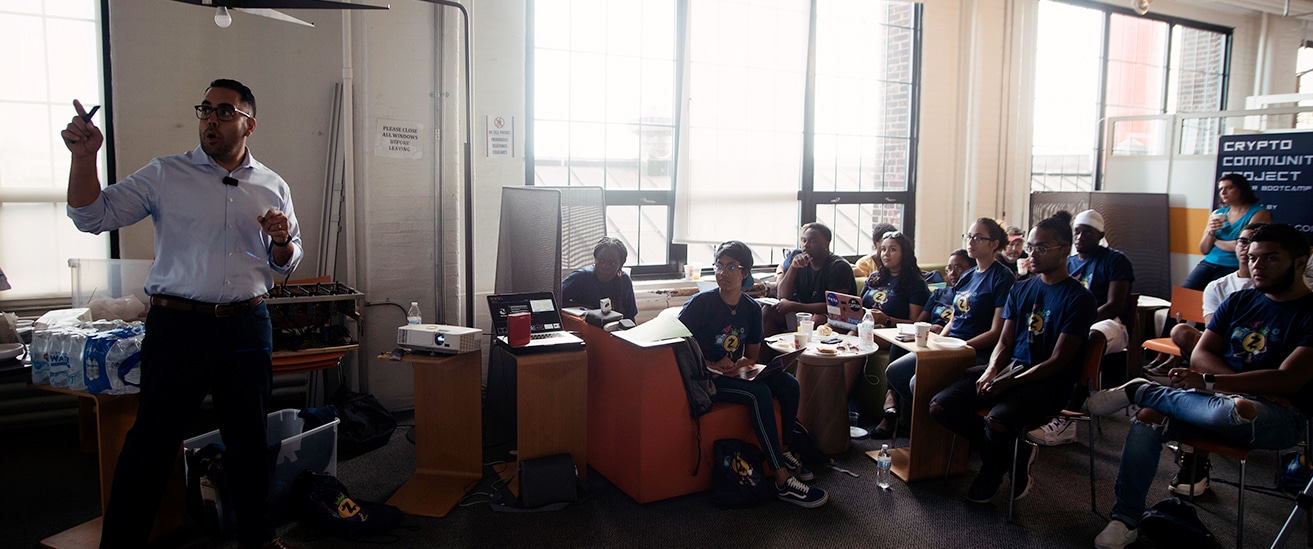Permission is rationed by the powerful.
And in places like the South Bronx, where banks are scarce and financial services are oppressive, opportunity has been suffocated.
In neighborhoods where mobility is expensive and complex, where families are often split across continents, where kids are dropping out of school to take care of their own children, where governments and administrative authorities have failed their constituents — potential has been stifled.
But there are ideas here, and beauty and resilience. And there are leaders — some of them teenagers — who are staring down inequity and driving engagement.
They are undaunted by the challenge of empowering their communities. With access, with tools, with a voice, and with permission — freedom — to turn the world upside down.
These are the Underestimated.
The Crypto Community Project (CCP) began around this idea of permission.
The South Bronx has exemplified urban blight for decades. This area has a history of being both low-income and high-crime. Progress has been made recently, but it doesn’t change the problematic reality on the ground. The Bronx is the Bronx, and Morrisania is the poorest congressional district in the United States. If there is a population that needs cryptocurrency, it is this one.
I began my opening talk at CCP by pointing through the window at the Bruckner Expressway, which connects to both the Sheridan Expressway and the Cross Bronx Expressway. These highways, the creation of Robert Moses between 1949 and 1972, split the South Bronx in half, driving down property values and destroying entire neighborhoods in the process.
Communities established over generations were moved in the name of progress. And while there is no way to know the precise number, there is evidence that over half a million residents were forcibly removed for the greater good of New York City and the Tri-State area. These parkways were built to connect the outer-suburbs with New York City without forcing drivers to roll through the neighborhoods of the Bronx.
The communities in the South Bronx did not grant permission to Robert Moses and the city of New York; they did not give permission because they did not have the power to grant it.
The city had the power.
The city, the epitome of centralized authority, made a decision they thought was in the best interest of the constituency as a whole. Those in the way had no choice in the matter. And no matter the platitudes about the greater good, the outsiders still suffer. Communities such as these lacked a voice, lacked access, lacked power, and lacked permission. The powers that be are the powers that be — until they aren’t.

My inspiration for CCP came from Andreas Antonopoulos and his lectures on open blockchains and their potential. He speaks with such conviction about these underserved populations — which, for me, are not far-flung. They are close to home.
Before the first CCP event, I wrote this blog post, which laid out my hopes for the project. Now that the event has occurred, the mission has become more clear.
CCP delivered cryptocurrency knowledge and hands-on education to a population that will use it, not as a novelty but as a necessity. With their hands on this revolutionary — in every sense of the word — technology, the students learned valuable skills and gained access to an unrivaled networking opportunity, but most importantly, eyes were opened. The value is hard to overstate.
Once this knowledge and technology are in the hands of people marginalized by the status-quo, the potential is evident.

The response was overwhelmingly positive from all the participants and speakers. There is a sense, a genuine sense, we are achieving something here. As an educator, what I witnessed over those two days in early August was true education. And I mean the word true as in real and actual. Students were willing to open their minds, to learn and absorb. Any educator knows the look of that fire in their eyes; it was stoked, and they wanted to learn more.
I recently heard that for people who grew up in Argentina — experiencing roller-coaster monetary policy — bitcoin makes sense; there is no need to convince them of its utility. I submit that if you grew up in the South Bronx, bitcoin makes sense.
The South Bronx is devoid of banks, devoid of financial services. The borough is filled with check-cashing, payday loans, and other predatory international currency transfer services that can and do exploit populations that had no alternative.
There is an alternative now. It was invented in 2009 by Satoshi Nakamoto and grown and improved upon by those who believe privacy a human right.
With the help of Electric Coin Company, CCP took a first step in establishing a new, cryptocurrency-based economy in the South Bronx that creates equity and access in a way that no institution can grant, no matter how noble their intentions.
Institutions, both governmental and financial, have historically failed the South Bronx. What we are witnessing in real-time is the emergence of an era where they will become irrelevant, and more, unnecessary — all because of blockchain.
The Crypto Community Project is a crypto-focused education initiative that aims to create micro crypto-economies in underserved communities while helping recent high school graduates become crypto-ready and contribute to the industry. Learn more here.
